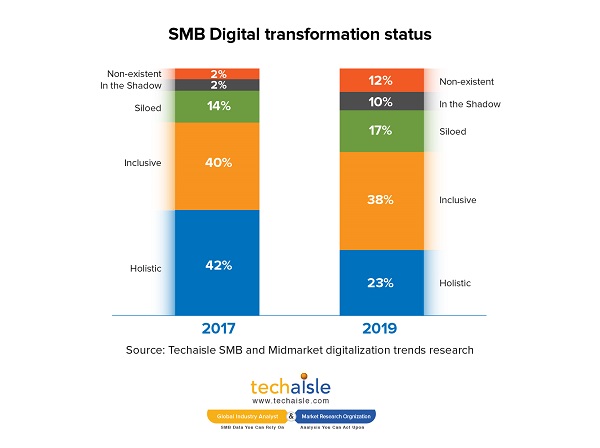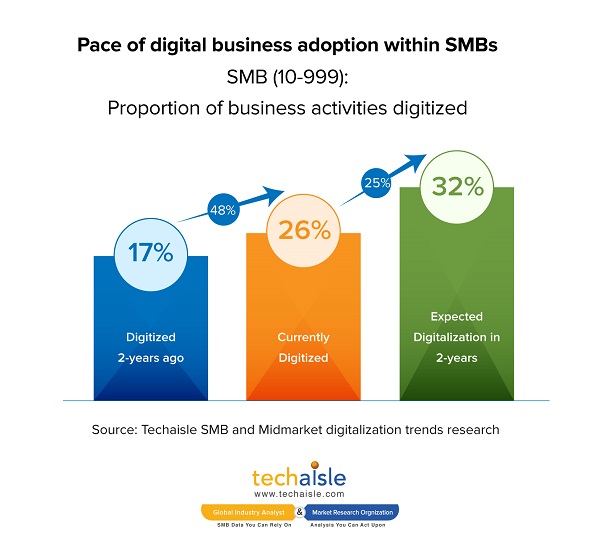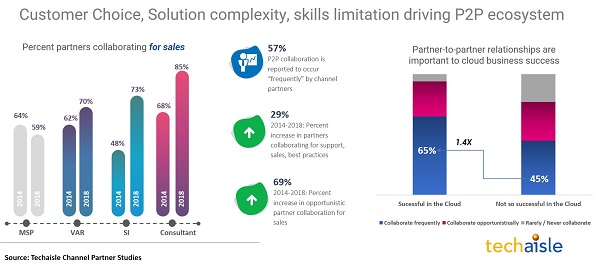Techaisle research into SMB approaches to digitalization shows a great belief in organizational commitment to digitalization strategies. 17% of small businesses and 31% of midmarket firms, down from more than 40% two years ago, believe that they are “holistic” with respect to digital transformation – that within their firms, the Internet and digital technologies impact every aspect of the business and are at the core of organizational strategy. Another large proportion of the SMB population – 32% of small businesses, 45% of midmarket firms – report that their organizations are best categorized as “inclusive,” seeing digital as important to the business, but as a relatively minor factor in strategic planning, and not having organization-wide impact. Lesser proportions of both populations see themselves as ‘siloed’ with respect to digital initiatives, but within 19% of small businesses, up from 5% in 2017, digital is not seen as core to their operations.

Pace of digital business adoption within SMBs
To add context to the previous data set, figure below shows how rapid the take-up of digital business within the SMB community has been and is expected to be over the next two years. Overall, SMBs expect 32% of business activities to be digitized by 2021, which will be up from 17% in 2017, nearly double. On average, roughly a quarter of small business and midmarket companies’ operational processes are digitized today: this represents a 51% increase (from 16%) within small business and a 47% (from 18%) increase within midmarket firms over the past two years, with a further 24%-28% increase (to nearly one-third of all processes) expected by the end of 2021. Suppliers selling into the SMB market with a digitalization position/messaging strategy should find a large number of firms looking to accelerate digital business initiatives.

Constraints to SMB digital strategies
A follow-on question about inhibitors found that 30% of SMBs “lack the skills” to embrace digital business practices; nearly as many (28%, rising to 36% in small business) cite staff or management reluctance to change current practices as a barrier to digital business adoption, and substantial proportions of the SMB community also point to “lack of investment capital/budget” (26%, and again, higher within small business) a risk averse corporate culture (24%) and inadequate installed technology (23%). In all, seven different constraints were cited by at least 20% of SMB respondents – highlighting the fact that SMBs face numerous challenges to development and adoption of effective digital business strategies.
Related SMB survey research reports:
US SMB & Midmarket Digitalization Trends
US Midmarket Digital Transformation Trends
US SMB & Midmarket SaaS Adoption Trends
Europe SMB & Midmarket SaaS Adoption Trends
Asia/Pacific SMB & Midmarket SaaS Adoption Trends
Latin America SMB & Midmarket SaaS Adoption Trends
White papers
Prologue and Epilogue of Digitalization in SMB Market
Digital Transformation for the Modern Midmarket: Red Paper
Future of Work - Interwork: the next step in connected businesses
Digital Transformation & the Future of Reseller Channel
















